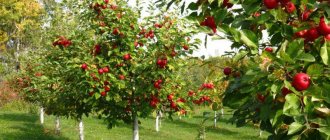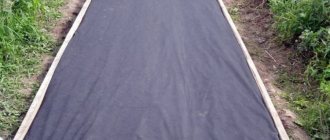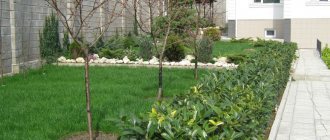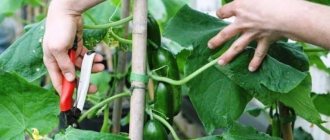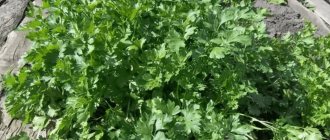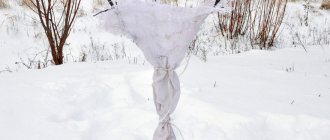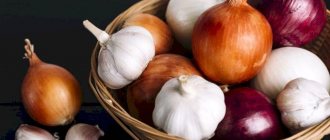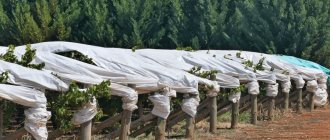Young fruit trees must be covered for the winter - this is necessary, since frosts can damage their root system and cause the death of the plant. Newly planted fruit plants in the garden should begin to be prepared before frost begins. The timing of covering fruit crops depends on the climate of the region where they are grown. Also, climatic conditions influence how and with what to cover garden trees and whether it is necessary to wrap their trunks. Step-by-step photos and detailed instructions help inexperienced gardeners to properly prepare young plants for winter and get a good harvest in the future.
Why are young trees covered?
Trees that have recently been planted in the garden need to be covered for the winter. Such fruit plants are wrapped in various materials that protect them from unfavorable winter conditions. It is important to insulate for the winter those fruit trees whose bark is still thin. This measure helps to eliminate several problems at the same time, which can subsequently not only reduce the yield of fruit crops, but also cause their death. You need to cover the trees in your garden for the winter to:
- provide shelter for the bark from bright sunlight;
- prevent the appearance of frost holes;
- save plantings from damage by cold winds;
- prevent hares, mice and other rodents from gnawing on the bark.
Attention! Not all fruit trees need to be covered. First of all, young non-zoned specimens and heat-loving crops - apricot, apple, pear, plum, peach - are insulated. Plants with a shallow root system also need shelter from frost.
Warming the tree trunk circle - mulching
Winter mulching in its purpose differs from its spring counterparts in that its goal is not just to protect the soil and plants from drying out and weeds, but to become a so-called “coat” for the cold season. And without a doubt this method works great.
Mulching and what it is made from can be divided into two main types - permanent mulch and dynamic mulch, let's talk about their differences.
Permanent mulching is most often a decorative solution with a beneficial effect; gravel, sand, pebbles or stone chips are used for its construction. This mulch is laid and left in a permanent place under trees or in a flower garden, and it, in turn, performs its protective and decorative functions.
Dynamic mulching is a more natural, but so to speak, “disposable” way to protect a plant; for its construction, natural materials are available to all of us, such as hay, fallen leaves, some types of sawdust, peat and ready-made compost. This method is not at all decorative, but it is very useful - in addition to insulation, the soil, and therefore the plant, will receive useful macro and microelements.
Mulching with humus or compost should be done in a layer of no more than 7 centimeters - to avoid rotting
Immediately before mulching, it is recommended to treat the soil around the tree trunk with a fungicide solution. If you decide to use humus or compost, then the mulch layer should not exceed 7 centimeters (to avoid rotting); other materials can be laid in a 10 centimeter layer. If the climate in your area is too harsh, it would be better to add spruce branches to cover the mulch.
Where do you start preparing?
Before sheltering young trees for the winter, gardeners carry out certain preparations. It is required to prevent diseases, remove pests and reduce the risk of accidental damage to plants during the winter season. Before the first autumn frosts and before the immediate insulation of individual young specimens of fruit-bearing trees, do the following:
- Clear the garden of fallen leaves, fruits and branches. During such cleaning, special attention is paid to the tree trunk circles, since these plant debris may contain pest larvae, bacteria, viruses and fungal spores. If not removed, after winter they can potentially cause deterioration in the condition of young trees.
- Young plants, as well as the soil in their trunk circle, are treated with a vitriol mixture. Use a solution of copper or iron sulfate according to the instructions. This treatment helps eliminate the vast majority of harmful insects that attack fruit crops.
- If there are lichens or mosses on the shoots or trunk, they are cleaned off, since such “neighborhood” can be very harmful to young plants.
- The lower part of the trunk is whitened with a solution of freshly slaked lime (2 kg dissolved in 10 liters of water and 500 g of copper sulfate added). This is done to prevent cracking of the bark due to temperature changes in winter. Whitewashing also protects the young bark from rodents.
The final stage of preparing young fruit trees is autumn formative pruning of the crown. It is carried out in order to improve the growth of the specimen for the next year and remove all unnecessary shoots, which only draw the plant’s strength onto itself, but do not bring any benefit. Thin branches that have not become lignified are cut with sharp pruning shears, and thicker ones with a garden saw. The instrument is disinfected before the procedure. After pruning is completed, all damage is treated with garden varnish, RanNet paste or another similar preparation.
“Weaknesses” of covering with spruce branches
Many may ask: “Where can I get so much spruce branches if there are no fir trees nearby or I don’t live in a forested region?” And any cutting down of trees is regulated by the Forest Code of the Russian Federation, according to which branches are allowed to be taken exclusively from felled forests in areas of felling and sanitary cleaning, or from naturally fallen coniferous trees. Otherwise, you may run into a fine.
In addition, brought spruce branches can become a source of infections such as fusarium, facidiosis, brown and common scute, and alternaria. And some pests (bark beetles, longhorned beetles or pine beetles) can easily be brought to our sites.
To exclude this, you should always carefully look at the branches for black plaque, rust, yellowed branches, uncharacteristic growths and bare areas on the bark.
To prevent such ailments, some gardeners simply soak spruce spruce branches in solutions of biofungicides and only then send them to the beds for their intended purpose.
A significant “minus” is also that inevitably falling pine needles in large quantities can get into the soil and further acidify it. It’s one thing when the plants in the garden prefer acidic soil (this will even benefit them), it’s quite another when they are lovers of an alkaline environment.
There is a way out - in response, deoxidize with dolomite flour, chalk, or first protect the area with a layer of compost or low-lying peat (and in the spring, remove the top layer along with the needles).
Timing of tree covering
For the winter, young trees need to be covered before the onset of frost, but it is important not to insulate them too early. Gardeners determine the exact dates when they need to start preparing garden crops for winter, taking into account the climatic conditions of the region and the current weather. First of all, they look at the average daily temperature, which should be approximately +10˚ C. When the thermometer mark on the street drops to 0˚ C, the garden should already be completely insulated. The approximate time for organizing the insulation of young fruit trees is:
- South - Krasnodar, Crimea, Caucasus - the second half of November and the first ten days of December.
- Middle zone - Moscow region, Volga region and other regions - the last days of October, the first ten days of November.
- Northern regions - the Urals, Siberia - from the last days of September to the last ten days of October.
- Far East - from the beginning of October until its last days.
- Leningrad region - from mid-October to the first days of November.
Attention!
In the southern regions, there is no need to wrap the trunks of young trees for insulation. However, it is worth organizing their protection from rodents. Building materials are often used for this.
When to cover plants with spruce branches
On the one hand, warming too early can cause excessive damping of plants, so it is customary to wait until stable sub-zero temperatures of about -5 degrees are reached. Typically, this temperature is established from late October to mid-November (depending on the region).
Short-term night frosts do not have time to harm plants that require protection - on the contrary, their impact causes a slight hardening before the unpredictable winter.
Therefore, there is no specific answer to the question “when to cover with spruce branches” - all that remains is to monitor the weather forecasts.
What is recommended to wrap the trunks with?
It is recommended to wrap the trunks of fruit trees grown in regions with cold climates with different materials. The choice of a particular one depends on how much the outside temperature drops during the winter season. Each of the materials and methods for protecting fruit crops from frost and other unfavorable factors that affect young plants in winter has advantages and disadvantages.
How you can and cannot mulch trees for the winter.
But mulching is only beneficial if you use the right mulching product. Using the wrong mulch can be dangerous for your tree.
Using compost or well-rotted manure to mulch your fruit trees in the fall is a bad idea. This is because nutrient-rich compost or manure will give your trees a boost as they prepare to go dormant. Your tree may produce tender new shoots that will die in the first frost of winter, and the plant will not have time to transfer nutrients from the leaves to the roots, making it difficult to survive the winter.
So which mulch should you choose? One that decomposes slowly: straw or mulch from hardwood trees, for example. Some people even mulch with gravel. These products successfully insulate the tree's roots from climate stress until it breaks dormancy in the spring.
Necessary materials
To protect young fruit trees in winter, it is imperative to prepare covering materials and ensure the safety of the plant from insects and rodents. Simply wrapping the trunk in a plastic cocoon is not enough. If rats, hares and mice appear on the site, there is a risk of damage to the thin bark of young trees. For normal protection, it is recommended to prepare the following materials:
- heat insulator - spruce branches, agrofibre, or other insulation;
- fabric for tying - wire, tape, polyethylene, rope;
- fence - plastic or metal solid mesh;
- insecticides and pesticides - to kill pests and repel them.
On a note!
Bordeaux mixture can be used as a complex solution that is completely harmless to the plant. It is used to treat covering materials and soil in the tree trunk circle.
How to protect trees from damage by animals in winter?
Mice, hares and deer can damage your trees and shrubs in winter by feeding on twigs and bark, leaves and stems.
The best general strategy for protecting your trees and shrubs from animals is to reduce the area, create physical barriers such as covering the trunk with glass wool or mesh over paper or burlap wrapping, or installing plastic barriers.
But if you have a lot of trees or shrubs on your property, using screens and wraps may be too costly and time-consuming. In such situations, repellents may be the best solution.
The repellent is not poison, the drug simply scares away animals with an unpleasant and pungent odor. For example, one of the best rodent repellents is Freitenmouse, VE. You can spray the product on trees or shrubs in late fall. Typically, in most cases, one application is sufficient to protect trees for one winter.
How to cover properly
In young fruit trees, the parts most susceptible to damage in winter are the roots and trunk. They can freeze when the temperature drops significantly or suffer from rodents and insects. To ensure normal protection of the tree, after preparing all the materials and carrying out the treatment with pest control agents, you need to properly cover the tree. The main rules are:
- Be sure to fertilize the soil in the tree trunk circle and mulch it with leaf litter, wood shavings or sawdust.
- The root area of the trunk must be wrapped more tightly - this will provide additional protection from pests and temperatures.
- After laying the film or agrofibre, you can tie spruce or juniper spruce branches to the trunk - no less than 1 m upward from the ground.
- If a lot of snow falls in winter, be sure to rake it up to the trunks of young trees.
- It is recommended to additionally spray the covering material and spruce branches with naphthalene or another rodent repellent.
- To protect the roots in the ground, it is better to place a protective net at a distance of 20-30 cm from the trunk.
Why are the branches of conifers so loved by gardeners and gardeners?
First of all, you can stock up on this natural material without investing money (ideal when the necessary trees grow on their own site or there are a lot of branches left after trimming decorative conifers). And with the arrival of warm days, there will be no need to wash, clean and dry it for storage - just put it in the compost pit, and that’s it (yes, this is a one-time use product only).
Over time, we will get additional natural humus, i.e. free fertilizer. Another option is to dry and burn and, again, get high-quality ash at the output.
In addition, spruce branches have many more advantages:
- it allows air to pass through perfectly, supporting natural ventilation;
- prevents damping off of covered crops;
- will reliably protect against sunburn both in winter and early spring;
- perfectly retains snow - the main protection against freezing;
- does not accumulate moisture like film or leaves, for example;
- the branches never cake and form thick impenetrable crusts, like a regular snow shelter;
- the fallen needles will serve as an additional nutritional component for plants;
- its spines do a good job of repelling hungry rodents, and some insects do not like its specific smell;
- bactericidal and antiseptic properties will serve as disease prevention.
It has been established that under a good layer of spruce branches (provided that there is enough snow on top), even in bitter frosts, the temperature does not drop below -5 degrees.
The root system of some trees and garden crops may freeze at temperatures below -10 degrees, if such indicators last more than 5 days and there is no snow cover. And spruce spruce branches will completely protect them; it will also protect the trunks from cracks that occur as a result of sudden temperature changes during the winter.
Methods and types of insulation
Apple trees that have been properly prepared and insulated begin to grow painlessly in the spring and open their buds.
Warming of wood is carried out after preliminary preparation. It consists of pruning, cumulative watering and whitewashing of the trunk.
After the onset of cold weather at a persistent negative temperature of about -10˚C, insulation begins.
There are two types of apple tree insulation:
- insulation of the root system;
- insulation of the above-ground part.
The root system must be protected from freezing during the winter. This can be done in several ways.
- Mulching the tree trunk circle. You can use shavings, humus, straw, and peat as mulch.
- Trample the fallen snow.
- Place coniferous spruce branches around the trunk. This will also be an obstacle for rodents.
- Hilling. The tree trunk circle is covered with rotted manure to a height of 20 cm. In the spring, the pile is raked, freeing the root collar.
READ ALSO: Characteristics of the Streifling apple tree variety with reviews from gardeners
Insulation of the above-ground part involves protecting the tree trunk and skeletal branches or the entire tree (columnar apple tree, seedlings).
Various methods are used.
- Construction of fences around a tree to accumulate snow.
- Wrapping with insulating materials.
- Wrapping the trunk and skeletal branches with newspapers, rags, rags, burlap.
- Applying a coating of equal parts clay and mullein with the addition of lime mortar to the trunk and skeletal branches.
When to wrap trees in the fall. Necessary materials
First of all, the basal neck requires cover. This must be done using material that allows air to pass through; A simple old stocking will do just fine. After this, it is necessary to protect the tree trunk. Sugar bags are suitable for this purpose, but the film must be removed from them before the procedure. You can also use regular newspapers or burlap and even old rags. Together with the trunk, the lower branches are also partially closed.
Don’t rush to throw away the sugar bag after use - this material is perfect for covering the tree trunk and lower branches of an apple tree for the winter
In winter, you need to create a snow cushion for the tree by throwing more snow on it, this will help protect the roots and root collar from severe cold.
Another good material for insulating an apple tree is agrofibre, although it is quite expensive. However, it provides reliable protection for trees both from frost and from uninvited toothy guests. Buying agrofibre is not a problem; it is freely sold in any gardening stores.
You can turn to the experience of your ancestors and remember what apple trees were covered with in the old days. In earlier times, people protected apple trees with reeds, corn stalks, straw or branches of coniferous trees. These natural materials provide excellent protection for garden beauties from rodents and frost. However, reeds can sometimes serve as a haven for mice. Therefore, if you have chosen this type of insulation to protect your apple trees, it would be a good idea to spread the poison near the root collar.
Today has brought another widespread material for covering apple trees - these are ordinary plastic bottles. This material is available anywhere and in any quantity. In addition to providing high-quality shelter for the trunk and root neck of the tree, bottles perform the function of scaring away, making noise with every, even insignificant, breath of wind.
Toilet paper, or rather the cheapest, roughest and densest varieties, can also act as a covering material. The root neck is carefully (in several layers) wrapped with toilet paper; moving from bottom to top, they wrap the entire trunk completely and slightly grab the lower branches. You need to wrap the apple tree in at least three layers, and preferably 5 or 6, otherwise the paper will get wet and the wood will be exposed. For greater reliability, the toilet paper on top should be secured with twine so that the wind does not tear it off.
Many gardeners successfully use material such as foamed polyethylene used for thermal insulation of pipes. The insulation is cut along the weld seam and placed on the tree. To hold it better, you can secure it with twine or tape. In such a “fur coat” the apple tree will be warm and rodents are guaranteed not to get to it; In addition, such a shelter looks quite nice. In addition, this material is very cheap: 2 meters cost only about 30 rubles, and it can be used many times, removing it in the spring and using it again before the onset of winter, which eliminates the annual expenses for these needs.
Foamed polyethylene can be used as a “winter coat” for apple tree branches, which is cut along the weld and placed on the tree. Foamed polyethylene is a very practical and affordable material for covering apple trees.
Separately, it is worth mentioning materials such as roofing felt, polyethylene film and the like. Their distinctive feature is airtightness, so they can be used with some restrictions. As soon as the first thaws begin in the spring, such material should be immediately removed. If this is not done, a greenhouse effect will occur: the trunk will burn, which will negatively affect the tree (fungal formations will appear).
Preparing seedlings for the procedure
You may be interested in: How to care for bees for a novice beekeeperGrowing strawberries correctlyPopular greenhouses: popular rating
Before insulating trees for the winter according to the photo, you need to prepare the planting. First of all, the seedling is processed. The entire crop should be completely harvested. All rotten fruits must be disposed of. All foliage on the site is raked. Carrion can be a source of pathogenic microorganisms and diseases. For prevention, the plant can be treated with copper sulfate or a solution of potassium permanganate.
If the material is not used for the first time, it must be treated with the same preparations as the seedling. They begin to prepare the planting in September. The plant is watered abundantly. This contributes to better wintering.
As preparation, you need to trim off all damaged and dry branches. Additionally, fertilizing is required.
